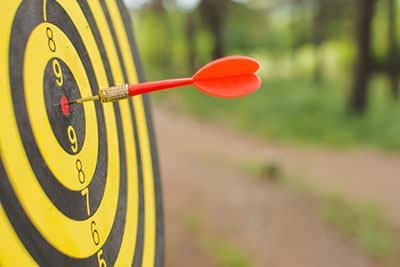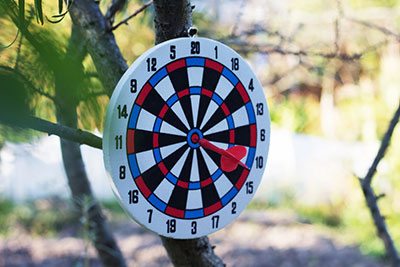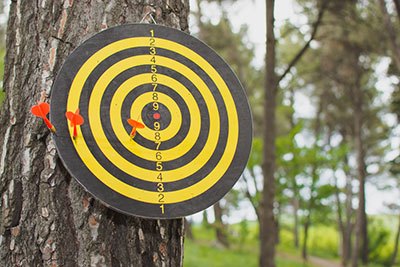Are you a passionate dart player? Have you been yearning to take the game outdoors but are scared of all the harsh elements that it might experience out there? Then, you’ve come to the right place!
In this guide, we discuss one of the most asked questions among dart players: Can I leave my dartboard outside?
We explore all corners of this controversial question and share our expert tips for how to have fun playing darts while still keeping your board in pristine condition.
So let's put on our detective hats and dive into this topic together!
More...
Take away key points:
- Although darts are an indoor game, you can still play darts outside too.
- Don't let the weather affect the boards, as fresh air, rain, cold, snow, or sunny day, and other elements can damage the boards.
- Always check the surrounding area and remove darts from the board when not playing, to protect your family, friends, or pets from injuries.
Can you set up a dart board outside?
If you need to know more about playing darts outside since they are played indoors, what precautions to take, and what type of dartboard you can use, read our guidelines below.
We will help you with your dilemmas.
Can you play darts outside generally?

Yes, you can play darts outside. However, it is important to keep in mind that darts are an indoor game, and playing outdoors can have some challenges. For instance, harsh weather conditions can affect the quality of outdoor play, and the dartboard should be hung at the correct height to ensure that the outdoor darts are played according to official rules.
Additionally, when not in use, the outdoor dartboards should be stored in a cool, dry environment. Overall, while it is possible to play darts outside, it is recommended that players primarily play indoors to ensure the best possible experience.
Is there any harm if you leave a dartboard outside?
Leaving a dartboard outside can result in several potential harms. For example:
- Damage to the board: Dartboards that are left outside can become damaged by exposure to moisture, sunlight, and other environmental factors. This damage can reduce the lifespan of the board and may even make it unusable.
- Safety hazards: Darts that are left outside can become rusty, and this rust can cause injury if someone is accidentally stuck with a dart. Additionally, leaving darts out in the open can pose a hazard for children and pets.
- Reduced accuracy: If a dartboard is left outside, it can become warped or uneven, which can affect the accuracy of throws and make the game less enjoyable.
- Increased need for replacement: Leaving a dartboard outside can lead to more frequent replacement due to damage caused by weather and other environmental factors.
In summary, leaving a dartboard outside can result in potential harm to the board, safety hazards, reduced accuracy, and the increased need for replacement. It's generally recommended to store dartboards indoors when not in use to prevent such problems.
Things to consider when setting up your dartboard and playing darts outside
Here are some of the crucial factors to consider when playing darts outside:
1. Don't let your bristle dartboard get wet
To avoid damaging a bristle dartboard, it's important to ensure it doesn't get wet since the sisal fibers are not designed to absorb moisture. Therefore, the initial step is to secure a spot or arrange for protection from outdoor elements. This could involve finding a location with an overhang or partial roof that affords shelter for the board if it's going to be outside for an extended period.
However, the most effective option would be to install a bracket that allows you to hang the board and remove it quickly when not in use. This approach gives us the flexibility to bring out the board only when it's dry, and you're ready to play.
2. Avoid direct sunlight and harsh weather conditions

It's advisable not to install the high-quality dartboard in a spot where it receives direct sunlight. This is particularly crucial if the dart board is new and you will be concerned about its condition.
In general, exposure to long-term direct sunlight is not ideal for a bristle board as it can cause fading and weaken the sisal fibers' integrity, which could damage the board. However, if it's an old board, for example, this may be less of a concern.
3. Always play safely
Playing darts outdoors means you may not have a spacious wall behind the board to intercept stray darts, which can occur more frequently after having a few beers. In such a situation, when playing darts outside, it's essential to set up the board in a location where there are no safety risks for kids or nearby people.
If you're mounting the board on a barn wall or another type of siding, this may be less of a concern. Nonetheless, it's important to ensure that the area designated for dart throwing is free of any potential hazards and clear of objects that someone could bump into while playing darts outside.
4. Follow the rules
Even when playing darts outdoors, it's crucial to adhere to the official dart rules, which include setting up the board at the appropriate height and marking the line at the correct throwing distance.
For example, the dartboard should be hung at a height of 5 feet 8 inches (measured from the bull's eye) with a throwing distance of 7 feet 9 1/4 inches. These are the standardized measurements for a standard bristle 18" dartboard. Given these requirements, there are various popular methods for mounting a dartboard when playing outdoors.
Different types of dartboards set outside
Below you can find some of the most popular dartboard options for outside use:
1. Barnsider
If you have a barn, shed, or other external structure, it could be an excellent spot to mount your dartboard outside to play darts. You can easily install the dartboard on the wall at the right height and start playing. If you're concerned about damaging the siding, you can use a dartboard backing or cabinet to protect it.
However, if it's an old barn or structure, you may not have to worry too much about damage. Although, having a custom backing surface or a rustic dartboard cabinet can still add to the aesthetics of the setup. If you're still worried about damaging the structure's siding, you may want to consider alternative mounting options.
2. Stand-alone option
These stand-alone have gained popularity recently. They consist of a single or double post with a dartboard surround attached to it. The dartboard is then mounted onto the surround.
You need to create a base for the post(s), which can be a heavy planter or something installed directly into the ground. However, you still must ensure that the setup is at the correct height.
With a single post setup, you'll have a smaller surround, meaning less protection from missed darts. On the other hand, with two posts, you can create a larger rectangular wall behind the dartboard, providing a more secure and stable environment for playing darts.
3. The tree option

Another preferred option is to mount the dartboard onto a tree. To do this, you need to attach a bracket to the tree to avoid nailing the board directly onto the trunk. This way, you can bring the board inside when necessary. To prevent damage to the tree, use French cleats and attach a custom backing surface or dartboard cabinet to them, taking it a step further.
However, the challenge with this method is getting the board level at the appropriate height. But if you find the right tree, it's outdoor darts in its purest form.
Each option has its pros and cons, and you'll have to weigh them to determine which is best for you. If you have a patio with weather protection and a solid wall, mounting the board there with a quality dartboard surround may be ideal. However, if you want to play in the yard, the two-post or tree method may be preferable.
With the outdoor dartboard set up in mind, the next consideration is the type of board to mount outside.
And, what type of dartboard should you use?
The best option for an outdoor dartboard would be an older bristle board that you don't mind exposing to the elements or damaging. However, if you don't have a spare board or don't want to use your indoor board outside, consider finding a basic, regulation-sized bristle board that's not too expensive but still provides the quality required for a great game of darts.
There are several options available in this category. It's worth noting that electronic board types aren't suitable for outdoor play due to the weather and environmental factors. Although they're entertaining and offer many options for playing various dart games with multiple players, they're not practical for outdoor use.
However, if you have a covered area that's fully protected but has open sections to the outside, you can use anything that's also suitable for indoor use. Essentially, this area is just a three-season room.
Can you use soft-tip darts and steel-tip darts when you play darts outside?
Yes, you can generally use both soft-tip darts and steel-tip darts when playing darts outside. However, it's worth noting that certain dartboards are designed for specific types of darts.
If you're using a bristle dartboard, it's typically designed for steel-tip darts. On the other hand, electronic dartboards often use soft-tip darts. Therefore, it's essential to ensure that the dartboard you're using is compatible with the type of darts you're using.
Another consideration is the environment in which you're playing. Soft-tip darts are generally more suitable for outdoor play because they're safer and less likely to cause damage to surfaces. Steel tip boards, on the other hand, can be dangerous and may cause damage if used improperly or thrown too hard.
Ultimately, the decision between the soft tip and steel tips comes down to personal preference and the type of dartboard available for use. It's crucial to ensure that you're following all safety guidelines and using the appropriate equipment for a safe and enjoyable outdoor dart game.
FAQs
Can a dartboard be left outside?
While it is possible to leave a dartboard outside, it is not recommended. It's generally advised to store dartboards indoors when not in use to prevent damage.
Are dart boards weatherproof?
No, dartboards aren't weatherproof. Most dartboards are not designed to be exposed to the elements and can become damaged by exposure to moisture, sunlight, and other environmental factors.
Is it bad to leave darts in a dartboard?
It's generally not recommended to leave darts in a dartboard for extended periods. Leaving the darts in the board can cause the tips to dull, warp, or corrode over time, which can affect their accuracy and make them unsafe to use. The weight of the darts can also cause the sisal or bristle material in the dartboard to move or deform, leading to an uneven playing surface.
Additionally, leaving darts on the board can increase the risk of accidents, particularly if children or pets are around. Therefore, it's advisable to remove the darts from the board when not in use to extend their lifespan and prevent any potential safety hazards.
What happens if a dart board gets wet?
If a dartboard gets wet, it can become damaged and potentially unusable. Many dartboards are made from sisal or bristle material that can absorb water and become warped or uneven, which can affect the accuracy of throws and make the game less enjoyable. Wet sisal bristles can also swell, causing them to pull loose from the glue layer and fall out of the board.
Additionally, if the darts become wet, they can rust or corrode, and if left on the board for too long, they can start to warp. Therefore, it's recommended to keep dartboards dry and avoid damp areas or humid spots where you hang the board. If the dartboard does get wet, it's essential to dry it thoroughly as soon as possible to prevent damage.
How to set up a dartboard outside?
Here are the steps to follow:
- Choose a suitable location: Find a location that provides enough space for players to throw darts safely, away from any breakable objects or other hazards. It's also important to make sure that the area is well-lit to ensure good visibility.
- Mount the dartboard: The dartboard should be mounted securely onto a sturdy backing board. You can use a piece of plywood or Masonite as a backing board and then mount the dartboard onto that. Make sure the mounting position is at the right height from the ground (5 feet, 8 inches) and the bullseye is level.
- Secure the dartboard: Use screws or nails to secure the backing board with the dartboard firmly to the wall or surface where it is to be placed.
- Protect the dartboard: If you want to keep the dartboard from getting damaged by the elements, you can purchase a weatherproof cover or place a tarp over it when not in use.
- Set up a scoreboard: Place a scoreboard nearby so that players can keep track of their scores during the game.
Remember to remove the darts from the board when you're done playing, and store them and the dartboard indoors to prevent damage due to exposure to moisture and other elements.
Final thoughts
You can play darts outside, but once you're finished playing, remove the darts from the dartboard to prevent damage. Also, do not leave your dartboard outside when you finish the game, as it affects the overall quality of the boards.
